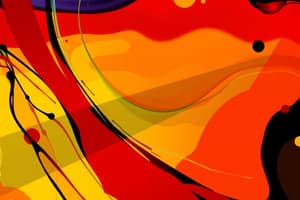Podcast
Questions and Answers
What is a key difference in tool requirements between digital and traditional art?
What is a key difference in tool requirements between digital and traditional art?
- Digital art requires only a tablet.
- Both forms require a computer.
- Digital art requires only software.
- Traditional art requires physical tools like paint and brushes. (correct)
Which aspect of digital art primarily contributes to its global reach?
Which aspect of digital art primarily contributes to its global reach?
- Instant shareability online. (correct)
- Advanced editing capabilities.
- Limitless creative possibilities.
- Low material costs.
What disadvantage does traditional art have compared to digital art regarding errors?
What disadvantage does traditional art have compared to digital art regarding errors?
- Errors often require starting over or repainting. (correct)
- Errors can be edited easily.
- Errors are less noticeable in traditional media.
- Errors can be undone at any time.
Which of the following tools is not typically associated with basic digital art creation?
Which of the following tools is not typically associated with basic digital art creation?
What is a significant benefit of digital art in terms of sustainability?
What is a significant benefit of digital art in terms of sustainability?
Which type of manipulation is primarily focused on enhancing the appearance of photographs?
Which type of manipulation is primarily focused on enhancing the appearance of photographs?
Which tool is utilized specifically for creating motion graphics?
Which tool is utilized specifically for creating motion graphics?
What aspect of traditional art is more pronounced compared to digital art?
What aspect of traditional art is more pronounced compared to digital art?
In which industry is the demand for digital artists highest?
In which industry is the demand for digital artists highest?
What is a main limitation of digital art's durability?
What is a main limitation of digital art's durability?
Flashcards
Digital vs. Traditional Art
Digital vs. Traditional Art
Digital art uses computer software and hardware to create artwork, while traditional art uses physical tools like paint and brushes.
Editing in Digital vs. Traditional Art
Editing in Digital vs. Traditional Art
Digital art is easily edited with features like undo/redo, while traditional art requires physical changes to the artwork.
Tools in Digital vs. Traditional Art
Tools in Digital vs. Traditional Art
Digital art tools include graphic design software, digital tablets, and styluses, whereas traditional art utilizes physical tools like paints, brushes, and pencils.
What is Photo Manipulation?
What is Photo Manipulation?
Signup and view all the flashcards
What is retouching?
What is retouching?
Signup and view all the flashcards
What is compositing?
What is compositing?
Signup and view all the flashcards
What are photo effects?
What are photo effects?
Signup and view all the flashcards
Typography & Graphic Design
Typography & Graphic Design
Signup and view all the flashcards
Motion Graphics & Animation
Motion Graphics & Animation
Signup and view all the flashcards
Importance of Digital Art
Importance of Digital Art
Signup and view all the flashcards
Study Notes
Photo Manipulation
- Photo manipulation involves enhancing or altering photographs for creative or practical use.
- Types include retouching (removing blemishes, correcting color), compositing (merging images), and adding effects (filters, textures, double exposure).
Typography and Graphic Design
- This involves using text and visuals to create posters, ads, and branding materials.
- Tools include Canva and Illustrator.
Motion Graphics and Animation
- This blends visuals and movement for animations and videos.
- Tools include After Effects and Toon Boom.
Digital Art Creation Tools
- Software: Beginner-friendly tools include Canva, Krita, and Photopea. Advanced tools include Adobe Creative Suite (Photoshop, Illustrator, After Effects), and Blender (3D modeling).
- Hardware: Tablets like Wacom and iPad (with Apple Pencil), and computers/laptops with high processing power for complex projects.
Importance of Digital Art
- Accessibility: Digital tools make art creation easier and more inclusive for all skill levels.
- Innovation: Enables creative freedom with new tools like VR and AI.
- Global Reach: Works are instantly shareable online, fostering collaboration and audience growth.
- Career Opportunities: High demand in industries like gaming, film, and animation.
- Sustainability: Minimizes physical impact by reducing environmental impact.
- Education and Learning: Simplifies learning through tutorials and digital tools.
Digital Art vs. Traditional Art
- Tools: Digital art uses tablets, software, and styluses; Traditional art uses physical tools like paintbrushes, canvases, and pencils.
- Accessibility: Digital art is globally accessible with minimal setup costs, whereas traditional art requires specific tools and materials.
- Editing: Digital art is easily editable with undo/redo options, while traditional art may require repainting or reworking to correct mistakes.
- Material Costs: Digital art is generally cost-effective in the long term, with no recurring material costs; traditional art has ongoing costs for materials like paint and canvas.
- Tactility: Digital art lacks the physical feel of traditional mediums; traditional art offers a hands-on experience and texture.
- Portability: Digital art is easily carried and shared digitally; traditional art requires physical storage and transport.
- Creativity: Digital art offers limitless possibilities with digital effects; traditional art focuses on mastery of physical techniques.
- Durability: Digital art exists in digital formats and is prone to obsolescence; traditional art is tangible but susceptible to wear and tear.
- Audience Reach: Digital art is instantly shareable online for a global audience; traditional art is often limited to exhibitions, galleries, or physical sales.
- Artistic Experience: Digital art often feels tech-driven; traditional art provides a more intimate and hands-on experience.
Studying That Suits You
Use AI to generate personalized quizzes and flashcards to suit your learning preferences.




